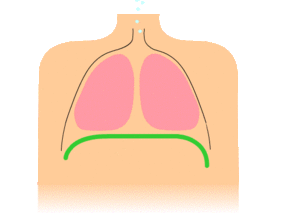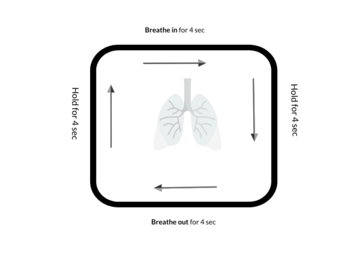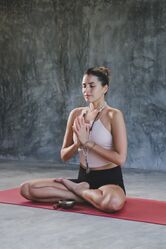Breathing Exercises: Difference between revisions
No edit summary |
No edit summary |
||
| Line 25: | Line 25: | ||
[[Pursed Lip Breathing|Pursed-lip breathing]] is a breathing technique that consists of exhaling through tightly pressed (pursed) lips and inhaling through the nose with the mouth closed. It is an effective way of slowing down breathing and increasing exhalation time allowing more air to be released with each breath cycle. | [[Pursed Lip Breathing|Pursed-lip breathing]] is a breathing technique that consists of exhaling through tightly pressed (pursed) lips and inhaling through the nose with the mouth closed. It is an effective way of slowing down breathing and increasing exhalation time allowing more air to be released with each breath cycle. | ||
This technique has been found to benefit people who have obstructive lung diseases eg [[Chronic Obstructive Pulmonary Disease Rehabilitation Class|chronic obstructive pulmonary disease]] (COPD)<ref>Very well health 8 Deep Breathing Exercises for Anxiety Available: https://www.verywellmind.com/abdominal-breathing-2584115#citation-11 (accessed 11.3.2022)</ref> and asthma leading to dyspnea during exertion. | This technique has been found to benefit people who have obstructive lung diseases eg [[Chronic Obstructive Pulmonary Disease Rehabilitation Class|chronic obstructive pulmonary disease]] (COPD)<ref>Very well health 8 Deep Breathing Exercises for Anxiety Available: https://www.verywellmind.com/abdominal-breathing-2584115#citation-11 (accessed 11.3.2022)</ref> and asthma leading to dyspnea during exertion. | ||
=== Deep Breathing === | === Deep Breathing === | ||
Revision as of 04:52, 21 November 2023
page under REVIEW- Please come back another time. (Singh, Prashna)
Original Editor - Lucinda hampton
Top Contributors - Lucinda hampton, Prashna Singh, Stella Constantinides, Robin Amel, Kim Jackson, Samuel Winter and Rishika Babburu
Introduction[edit | edit source]
Breathing is an function controlled by the automic nervous systmem and is also under volotional control. Breathing exercises are a form of exercise which can improve the overall efficiency at which the lungs function.[1]They can be helpful in individulals with both healthy lungs as well as those with impaired lung function. In the absence of disease our breathing becomes altered with stress and when left unchecked over time can result in disordered breathing patterns. (breathing pattern disorder) Disordered breathing can upset the oxygen and carbon dioxide exchange and contribute to anxiety, panic attacks, fatigue, and other physical and emotional disturbances.[2]
Benefits of breathing exercises include a variety of health-related reasons. eg: to enhance the respiratory system by improving ventilation; strengthening respiratory muscles; make breathing more efficient; and for relieving stress and anxiety.[3]
Diaphragmatic Breathing[edit | edit source]
Diaphragmatic breathing is a type of breathing exercise that helps strengthen the diaphragm, the main muscle that helps with breathing, as it represents 80% of breathing. Diaphragmatic exercises help to make people feel relaxed and rested.
This breathing exercise is also sometimes called belly breathing or abdominal breathing.
Technique:
- Position patient in a gravity-assisted position eg. semi fowler's positions
- Focusing on the Diaphragm - Place one hand on the chest and the other on your stomach. Take a slow deep breath, paying attention to which hand moves. In diaphragmatic breathing, the stomach hand should move most
- Slow the breathing - Inhale to fully inflate the lungs, then slowly exhale. Breathing out through the nose can help control exhalation rate. Pause briefly after exhaling then inhale again.
Pursed Lip Breathing[edit | edit source]
Pursed-lip breathing is a breathing technique that consists of exhaling through tightly pressed (pursed) lips and inhaling through the nose with the mouth closed. It is an effective way of slowing down breathing and increasing exhalation time allowing more air to be released with each breath cycle.
This technique has been found to benefit people who have obstructive lung diseases eg chronic obstructive pulmonary disease (COPD)[1] and asthma leading to dyspnea during exertion.
Deep Breathing[edit | edit source]
Deep breathing helps to relieve shortness of breath by preventing air from getting trapped in the lungs and helps inhalation of more fresh air to the base of the lungs. It may help the client to feel more relaxed and centered.
Technique:
- While standing or sitting, draw your elbows back slightly to allow your chest to expand.
- Take a deep inhalation through the nose.
- Retain your breath for a count of 5.
- Slowly release your breath by exhaling through the nose[2].
Active Cycle of Breathing Techniques[edit | edit source]
The Active Cycle of Breathing Techniques (ACBT) is an active breathing technique performed by the patient and can be used to mobilize and clear excess pulmonary secretions and to generally improve lung function. Once ACBT has been taught, the patient can be encouraged to use it independently without the supervision of a physiotherapist. This exercise does not require the use of any special equipment.
Box Breathing[edit | edit source]
Box breathing can be helpful with relaxation. Box breathing is a breathing exercise to assist patients with stress management and can be implemented before, during, and/or after stressful experiences. Box breathing involves visualizing a journey around the four sides of a square, pausing while traveling horizontally, and breathing in while traveling up the square and out while traveling down it. This exercise can be implemented in many environments, not requiring a calm environment to be effective.
- Step One: Breath in through the nose for a count of 4.
- Step Two: Hold your breath for a count of 4.
- Step Three: Breath out for a count of 4.
- Step Four: Hold your breath for a count of 4.
- Repeat[3]
Research Findings[edit | edit source]
Breathing affects all body systems; these systems in turn influence breathing. Optimal breathing patterns help to maintain homeostasis, but when breathing is disrupted, significant issues can arise.
Examples of how breathing can help in health outcomes are shown below:
- Breathing exercises can improve pulmonary function, respiratory muscle strength, exercise capacity, dyspnea, and health-related quality of life in patients with COPD[4].
- Evidence suggests that diaphragmatic breathing may decrease stress as measured by physiologic biomarkers, as well psychological self-report tools[5]
- Evidence exists to support the use of breathing exercises in the treatment of chronic, nonspecific low back pain.[6]
- Breathing-based meditation decreases posttraumatic stress disorder (PTSD) symptoms in U.S. military veterans.[7]
- The way of breathing decisively influences autonomic and pain processing. Deep slow breathing in concert with relaxation are essential feature in the modulation of sympathetic arousal and pain perception. Thus can be useful in chronic pain management.[8]
- Breathing exercises for adults with asthma may have some positive effects on quality of life, hyperventilation symptoms, and lung function[9].
See The Science of Breathing Well
References[edit | edit source]
- american lung association
- Medical dicationary breathing exericses https://medical-dictionary.thefreedictionary.com/breathing+exercise
- ↑ Very well health 8 Deep Breathing Exercises for Anxiety Available: https://www.verywellmind.com/abdominal-breathing-2584115#citation-11 (accessed 11.3.2022)
- ↑ Healthline 10 Breathing Techniques for Stress Relief and More Available:https://www.healthline.com/health/breathing-exercise (accessed 12.3.2022)
- ↑ Norelli SK, Long A, Krepps JM. Relaxation Techniques.[Updated 2021 Jul 26]. StatPearls [Internet]. Treasure Island (FL): StatPearls Publishing. 2021. Available;https://www.ncbi.nlm.nih.gov/books/NBK513238/ (accessed 11.3.2022)
- ↑ Lu Y, Li P, Li N, Wang Z, Li J, Liu X, Wu W. Effects of home-based breathing exercises in subjects with COPD. Respiratory care. 2020 Mar 1;65(3):377-87. Available: https://pubmed.ncbi.nlm.nih.gov/31719191/(accessed 12.2.2022)
- ↑ Hopper SI, Murray SL, Ferrara LR, Singleton JK. Effectiveness of diaphragmatic breathing for reducing physiological and psychological stress in adults: a quantitative systematic review. JBI Evidence Synthesis. 2019 Sep 1;17(9):1855-76. Available: https://pubmed.ncbi.nlm.nih.gov/31436595/(accessed 12.3.2022)
- ↑ Anderson BE, Bliven KC. The use of breathing exercises in the treatment of chronic, nonspecific low back pain. Journal of sport rehabilitation. 2017 Sep 1;26(5):452-8. Available: https://journals.humankinetics.com/view/journals/jsr/26/5/article-p452.xml(accessed 12.3.2022)
- ↑ Seppälä EM, Nitschke JB, Tudorascu DL, Hayes A, Goldstein MR, Nguyen DT, Perlman D, Davidson RJ. Breathing‐based meditation decreases posttraumatic stress disorder symptoms in US Military veterans: A randomized controlled longitudinal study. Journal of traumatic stress. 2014 Aug;27(4):397-405. Available:https://pubmed.ncbi.nlm.nih.gov/25158633/ (accessed 12.3.2022)
- ↑ Busch V, Magerl W, Kern U, Haas J, Hajak G, Eichhammer P. The effect of deep and slow breathing on pain perception, autonomic activity, and mood processing—an experimental study. Pain Medicine. 2012 Feb 1;13(2):215-28. Available: https://pubmed.ncbi.nlm.nih.gov/21939499/(accessed 12.3.2022)
- ↑ Santino TA, Chaves GS, Freitas DA, Fregonezi GA, Mendonça KM. Breathing exercises for adults with asthma. Cochrane Database of Systematic Reviews. 2020(3). Available:https://pubmed.ncbi.nlm.nih.gov/32212422/ (accessed 12.3.2022)










